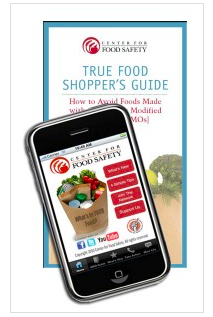The term genetically modified organism or GMO is sneaking into many news stories as of late. Consumers are becoming more vocal about their rights to know what is in the food they’re purchasing. Currently, the U.S. has no laws requiring companies to label their foods as a GMO. Thankfully, The Center for Food Safety has created a food guide to aid shoppers the next time they head to the store.
The True Food Shopper’s Guide is a perfect tool for those looking to navigate any grocery store and avoid purchasing the unlabeled GMOs on the shelf. GMOs are foods that have been created in a lab. In these GMO labs, genes are artificially inserted into the DNA of foods crops or animals. The resulting GMO can be engineered with genes from bacteria, viruses, insects, animals, or even humans.
When polled, the majority of Americans said they would not choose a GMO food, if it were labeled. Since we do not have the luxury of labels, unlike most other industrialized countries, knowing what our foods contain is a mystery. However, the shopper’s guide takes away the wonder and puts the right to know back in the consumer’s hands.
The guide offers four basic tips to remember when food shopping.
- Buy organic. If it’s grown organically and made with organic ingredients, there are no GMOs.
- Look for “non-GMO” labels. No one is required to label, but many products are choosing to do so for their consumers.
- Avoid at-risk ingredients. The Center for Food Safety identifies four ingredients as risky, calling them the “Big Four.” This includes corn, soybeans, canola, and cottonseed used in processed foods. These items are most commonly made from GMOs.
- Buy the products listed in the shopping guide.
The guide is free and available as a download from the Food Safety website. There’s also a smart phone app available for those hoping to go paper free. The app makes the shopping experience even easier as it can be searched and referenced with ease.
The organization has broken all foods down into categories. Within each category, they list the non-GMO products and then a section labeled, “may contain GMO ingredients.” The guide’s categories include:
Fruits and Vegetables
Eggs
Fish
Meat and Fowl
Alternative Meat Products
Baby Foods and Infant Formula
Baked Goods
Cereals and Breakfast Bars
Energy Bars
Grains, Beans and Pasta
Canned Foods
Soups and Sauces
Frozen Foods
Condiments, Oils, Dressings and Spreads
Snack Foods
Sweeteners
Candy and Chocolate Products
Sodas, Juices and Other Beverages
Put the choice for real, true, food back in your hands. Get the free app or print the guide before your next trip to the store.
Also Read:
Monstanto Children’s Book is Nothing but Propoganda
Four Simple Tips to Avoid GMOs
Genetically Engineered Salmon May be Coming
